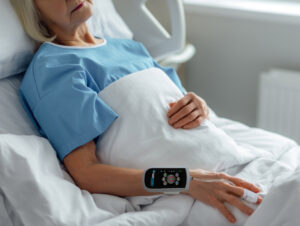
Managing Sepsis: The role of VitalStream for rapid fluid assessment
With September designated as Sepsis Awareness Month, and the tenth annual World Sepsis Day this September 13th, there is a renewed focus on this global health crisis which affects up to 50 million people a year and is associated with 20% of all deaths worldwide.
Sepsis is a life-threatening condition which occurs when the body’s response to infection starts a chain reaction that injures its own tissues and organs. If not identified and treated rapidly, sepsis can lead to shock, organ failure and death. For those that survive, the physical damage caused by sepsis can negatively affect their health for the rest of their lifetime. .
While anyone can get sepsis from a bacterial or viral infection (including COVID-19), those most at risk are patients in intensive care or recovering from a procedure, people with weakened immune systems, chronic health conditions and the elderly.
Despite being a common cause of death in hospitals, sepsis is frequently underdiagnosed in the crucial early stages. And while educational campaigns to raise staff awareness and the development of hospital systems such as the ‘Sepsis Six Bundle’ have helped deliver prompt treatment, there is still scope for improvement.
Prevention is key
For 30% of intensive care patients, blood pressure monitoring in clinical management is done through an invasive arterial catheter. These are not only uncomfortable but also carry an increased risk of bacterial infections which can lead to sepsis and other complications.
The best way to prevent sepsis, therefore, is to minimize the chance of initial infection, particularly in acute settings where hospital-acquired infections (HAIs) affect one in 31 patients on any given day.
Caretaker Medical’s VitalStream is a non-invasive monitoring system that effectively eliminates this infection risk, with a simple, low-pressure sensor that fits comfortably on the patient’s finger. This sensor measures continuous blood pressure alongside other advanced hemodynamic parameters (such as cardiac output, stroke volume, left ventricular ejection and heart rate variability) that are needed by clinicians to effectively assess and treat at-risk patients.
Identifying sepsis with VitalStream
Low blood pressure, increased heart rate and respiratory rate are physical indicators of sepsis, but even a brief hemodynamic change can damage the function of vital organs including the brain, heart and kidneys.
VitalStream marks the next generation of patient monitoring. It utilizes innovative, patented Pulse Decomposition Analysis technology to deliver ‘beat-by-beat’ blood pressure, heart rate, respiratory rate, cardiac output and perfusion data needed to effectively screen a patient for sepsis. VitalStream continuously monitors patients changing health to avoid gaps caused by intermittent monitoring, ensuring that any early signs of sepsis are not missed.
As a wireless system, it helps to untether patients from monitoring device boxes for increased patient mobility, while still providing uninterrupted data for clinicians to view either on a device or remotely via the cloud. The platform can also form part of a scalable system that utilizes additional wireless sensors to monitor other vital signs for a more complete picture of patient health.
For further efficiencies, automated reports and data collection can be collated into electronic medical records (EMRs), creating a streamlined workflow that reduces costs and saves time for clinicians.
Early identification and timely intervention is critical
Hospitals that execute the sepsis bundle guidelines within prescribed timelines have shown significantly lower mortality rates for patients diagnosed with severe sepsis and septic shock.
Simple and easy to use, noninvasive VitalStream can be up and running in just 60 seconds.
When every minute counts both in diagnosing and initiating treatment of sepsis patients, having the right monitoring tools to help identify onset is crucial. VitalStream’s continuous, noninvasive blood pressure and hemodynamic monitoring technology is better for clinicians, the hospital and ultimately, the patient.
Find out more at https://caretakermedical.net/
More medical news and events

Caretaker Medical Receives Inaugural Healthcare Tech Innovation Award and $200,000 Grant from Medical Society of D.C.
WASHINGTON, DC, UNITED STATES, April 2, 2025 /EINPresswire.com/ -Caretaker Medical is honored to announce it has been awarded the Healthcare Technology Innovation Award, along with…

Caretaker Medical Awarded the Grand Prize in NIH RADx Tech for Maternal Health Challenge
Caretaker Medical, a digital health company focused on developing hemodynamic monitoring devices, today announced that it has been awarded the $525,000 grand prize in the…

VitalStream offers continuous hemodynamic monitoring solution amid IV fluid shortage
Philadelphia, PA – October 9, 2024 – Caretaker Medical, a pioneer in advanced hemodynamic monitoring technology, is highlighting the critical role of its VitalStream solution…
